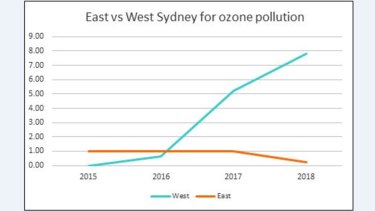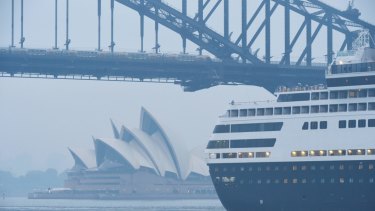
The region, on Sydney's south-west edge, has exceeded the PM2.5 standard for at least the past four years. Liverpool also had 10 days above the maximum recommended for ozone and 13 days above the maximum for the larger PM10 particles.
For ozone pollution, which can exacerbate asthma and other respiratory ailments, all monitoring stations west of Strathfield topped the national standard of 8 parts per hundred million on more than one day, up from half the sites in 2015.
None of the stations in the east exceeded that level last year, where the average was only 0.3 days compared with 7.8 days at western sites.

Pollution data collected by OEH monitors show ozone pollution levels have jumped in the west, compared with the east, in recent years.Credit:OEH
'Time to tighten up'
Kate Smolski, chief executive of the NSW Nature Conservation Council, said air pollution was "an invisible killer", and that it was time the Berejiklian government and other jurisdictions in Australia combined to tighten the national standards.
“The Australian standard for sulphur dioxide is 11 times higher than the World Health Organisation’s and almost three time higher than limits set in the United States," Ms Smolski said.
“Coal-burning power stations on the Central Coast and Hunter Valley are the major source of sulphur dioxide and oxides of nitrogen in Sydney’s air."

Sydney's east typically has better air quality in the east than inland areas.Credit:Nick Moir
Drought link
A spokeswoman for OEH said the state's overall air quality had improved over the previous 15-20 years but the drought had contributed to the recent jump in pollution.
"Across metropolitan Sydney, there has been no significant difference in particle pollution between Sydney East, Sydney North-west and Sydney South-west over the past four years, except for 2018 when the entire state’s air quality was impacted by increased dust from drought-affected areas and smoke from wild fires and hazard reduction burns," she said.
"Ozone levels can be higher in Western Sydney, particularly during hot summers," the spokeswoman said, adding NSW had just experienced its hottest year on record with January Sydney's hottest ever month. Sea breezes help ease pollution levels over eastern suburbs.
For its part, the Environment Protection Authority said air quality in NSW was comparable to parts of Australia and air pollution concentrations were low by world standards.
"There has been a long-term trend of declining emissions to air from industry since 2008-9 in NSW and the data from the recent National Pollution Inventory report shows this trend continues," a spokeswoman said.
Actions underway include efforts by the EPA to reduce the impact of wood heaters on air quality by encouraging the take-up of replacement of all heaters with new ones that meet stricter emission and efficiency standards.
Mortality risks
Ivan Hanigan, lead author of the paper recently published in Environment International, said Sydney has generally low levels of pollution on a global scale but the research showed "there is no real threshold of safe pollution".
While high ozone days are associated with chronic respiratory diseases and higher hospital admissions, PM2.5 particulates are small enough to enter the bloodstream, via the lungs, affecting the heart and brain.
“If you moved from a low pollution area [in Sydney] to a high pollution one, statistically you’d have something like a five per cent increase" in mortality risk, said Dr Hanigan, who is based at the Woolcock Institute of Medical Research and Sydney University.
“Humans make up to 40-50 per cent of the particle pollution," he said, with wood heaters, motor vehicles and coal-fired power among the largest sources.
“Fewer freeways, more public transport and zero-emissions electricity” were ways to ease the pollution, Dr Hanigan said.
While Australia has plans to strengthen national air pollution standards by 2025, that year "is a long time away and our results can be used to add a bit of momentum and urgency to that regulation process", he said.
Peter Hannam writes on environment issues for The Sydney Morning Herald and The Age.









 Add Category
Add Category